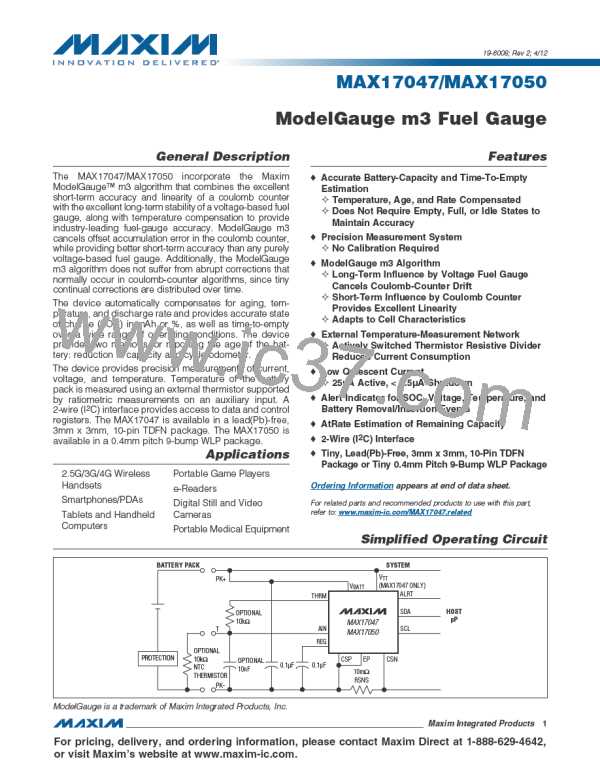MAX17047/MAX17050
ModelGauge m3 Fuel Gauge
The resulting output from the mixing algorithm does
not suffer drift from current measurement offset error
and is more stable than a stand-alone OCV estimation
algorithm; see Figure 4. Initial accuracy depends on the
relaxation state of the cell. The highest initial accuracy is
achieved with a fully relaxed cell.
OCV Estimation and Coulomb-Count Mixing
The core of the ModelGauge m3 algorithm is a mixing
algorithm that combines the OCV state estimation with
the coulomb counter. After power-on reset of the IC,
coulomb-count accuracy is unknown. The OCV state
estimation is weighted heavily compared to the coulomb-
count output. As the cell progresses through cycles in
the application, coulomb-counter accuracy improves
and the mixing algorithm alters the weighting so that
the coulomb-counter result is dominant. From this point
forward, the IC switches to servo mixing. Servo mixing
provides a fixed magnitude continuous error correction to
the coulomb count, up or down, based on the direction
of error from the OCV estimation. This allows differences
between the coulomb count and OCV estimation to be
corrected quickly. See Figure 3.
Fuel-Gauge Empty Compensation
As the temperature and discharge rate of an applica-
tion changes, the amount of charge available to the
application also changes. The ModelGauge m3 algo-
rithm distinguishes between remaining capacity of the
cell (RemCap
) and remaining capacity of the appli-
AV
MIX
cation (RemCap ) and reports both results to the user.
Fuel-Gauge Learning
The device periodically makes internal adjustments
to cell characterization and application information to
remove initial error and maintain accuracy as the cell
ages. These adjustments always occur as small under-
corrections to prevent instability of the system and
prevent any noticeable jumps in the fuel-gauge outputs.
Learning occurs automatically without any input from the
host. To maintain learned accuracy through power loss,
the host must periodically save learned information and
then restore after power is returned. See the Power-Up
and Power-On Reset section for details:
100%
COULOMB-COUNT INFLUENCE
SERVO MIXING
• Full Capacity Available to Application (FullCAP).
This is the total capacity available to the application
at full. FullCAP is updated near the end of charging
when termination is detected. See the End-of-Charge
Detection section.
OCV
INFLUENCE
0%
0
0.50
1.00
1.50
2.00
CELL CYCLES
Figure 3. ModelGauge m3 OCV and Coulomb-Count Mixing
TYPICAL OCV ESTIMATION
ERROR AS CELL IS CYCLED
MAXIMUM COULOMB-COUNTER ERROR
(SHADED AREA)
ModelGauge m3
OCV + COULOMB-COUNT MIXING
MAXIMUM ERROR RANGE
TIME
Figure 4. ModelGauge m3 Algorithm Mixing Conceptual Illustration
���������������������������������������������������������������� Maxim Integrated Products 10

 MAXIM [ MAXIM INTEGRATED PRODUCTS ]
MAXIM [ MAXIM INTEGRATED PRODUCTS ]